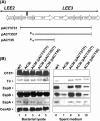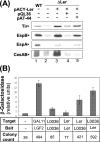Multiple functions of l0036 in the regulation of the pathogenicity island of enterohaemorrhagic Escherichia coli O157:H7
- PMID: 16248852
- PMCID: PMC1360710
- DOI: 10.1042/BJ20051201
Multiple functions of l0036 in the regulation of the pathogenicity island of enterohaemorrhagic Escherichia coli O157:H7
Abstract
Diarrhoeagenic enterohaemorrhagic Escherichia coli and enteropathogenic E. coli attach to human intestinal epithelium and efface brush-border microvilli, forming an A/E (attaching and effacing) lesion. These human pathogens are phenotypically similar to the mouse pathogen Citrobacter rodentium. Genetically, they all have a homologous set of virulent genes involved in the A/E lesion, and these genes are organized on a LEE (locus of enterocyte effacement), a pathogenicity island. This island comprises 41 specific open reading frames, of which most are organized at five operons, LEE1, LEE2, LEE3, LEE4 and tir (LEE5). The expression of the LEE genes is regulated in a complicated manner, and current knowledge is that there are at least two positive regulators, Ler (LEE-encoded regulator) and GrlA (global regulator of LEE activator), and one negative regulator, called GrlR (global regulator of LEE repressor). In enterohaemorrhagic E. coli, GrlA is encoded by l0043, whereas GrlR is encoded by l0044. Here we report a fourth regulatory gene located in LEE3, namely l0036. Its expression is tightly controlled. When overexpressed, this factor, named Mpc (multiple point controller), interacts with Ler and suppresses the expression of the LEE proteins. When the translation is not initiated or terminated before maturation, the type III secretion of effectors is completely abolished. Therefore, together with the fact that several cis elements reside in the region that l0036 spans, l0036 appeared to have multiple functions in the regulation of LEE expression.
Figures







Similar articles
-
GrlA of enterohemorrhagic Escherichia coli O157:H7 activates LEE1 by binding to the promoter region.J Microbiol Immunol Infect. 2008 Feb;41(1):9-16. J Microbiol Immunol Infect. 2008. PMID: 18327421
-
Identification and characterization of NleA, a non-LEE-encoded type III translocated virulence factor of enterohaemorrhagic Escherichia coli O157:H7.Mol Microbiol. 2004 Mar;51(5):1233-49. doi: 10.1046/j.1365-2958.2003.03911.x. Mol Microbiol. 2004. PMID: 14982621
-
Identification of a negative regulator for the pathogenicity island of enterohemorrhagic Escherichia coli O157:H7.J Biomed Sci. 2004 Nov-Dec;11(6):855-63. doi: 10.1007/BF02254371. J Biomed Sci. 2004. PMID: 15591783
-
[Plasticity of bacterial genomes: pathogenicity islands and the locus of enterocyte effacement (LEE)].Berl Munch Tierarztl Wochenschr. 2004 Mar-Apr;117(3-4):116-29. Berl Munch Tierarztl Wochenschr. 2004. PMID: 15046458 Review. German.
-
EPEC's weapons of mass subversion.Curr Opin Microbiol. 2005 Feb;8(1):28-34. doi: 10.1016/j.mib.2004.12.010. Curr Opin Microbiol. 2005. PMID: 15694854 Review.
Cited by
-
Correlating levels of type III secretion and secreted proteins with fecal shedding of Escherichia coli O157:H7 in cattle.Infect Immun. 2012 Apr;80(4):1333-42. doi: 10.1128/IAI.05869-11. Epub 2012 Jan 17. Infect Immun. 2012. PMID: 22252878 Free PMC article.
-
PIPS: pathogenicity island prediction software.PLoS One. 2012;7(2):e30848. doi: 10.1371/journal.pone.0030848. Epub 2012 Feb 15. PLoS One. 2012. PMID: 22355329 Free PMC article.
-
An O island 172 encoded RNA helicase regulates the motility of Escherichia coli O157:H7.PLoS One. 2013 Jun 13;8(6):e64211. doi: 10.1371/journal.pone.0064211. Print 2013. PLoS One. 2013. PMID: 23785398 Free PMC article.
-
After the Fact(or): Posttranscriptional Gene Regulation in Enterohemorrhagic Escherichia coli O157:H7.J Bacteriol. 2018 Sep 10;200(19):e00228-18. doi: 10.1128/JB.00228-18. Print 2018 Oct 1. J Bacteriol. 2018. PMID: 29967119 Free PMC article. Review.
-
A putative lytic transglycosylase tightly regulated and critical for the EHEC type three secretion.J Biomed Sci. 2010 Jun 29;17(1):52. doi: 10.1186/1423-0127-17-52. J Biomed Sci. 2010. PMID: 20587027 Free PMC article.
References
-
- Frankel G., Phillips A. D., Rosenshine I., Dougan G., Kaper J. B., Knutton S. Enteropathogenic and enterohaemorrhagic Escherichia coli: More subversive elements. Mol. Microbiol. 1998;30:911–921. - PubMed
-
- Mellies J. L., Elliott S. J., Sperandio V., Donnenberg M. S., Kaper J. B. The Per regulon of enteropathogenic Escherichia coli: identification of a regulatory cascade and a novel transcriptional activator, the locus of enterocyte effacement (LEE)-encoded regulator (Ler) Mol. Microbiol. 1999;33:296–306. - PubMed
-
- Friedberg D., Umanski T., Fang Y., Rosenshine I. Hierarchy in the expression of the locus of enterocyte effacement genes of enteropathogenic Escherichia coli. Mol. Microbiol. 1999;34:941–952. - PubMed
Publication types
MeSH terms
Substances
LinkOut - more resources
Full Text Sources
Other Literature Sources

